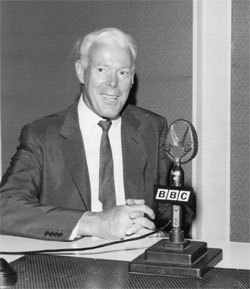The Right Colour 1 September 1986
Trevor Leggett was head of the Japanese Department of the BBC.

This is one of his broadcasts to Japan
Zubari for 1 September 1986
Some years ago, I read a short story about the education of small Japanese children in Meiji times. But I have forgotten the name of the Japanese to whom it referred. He lived as a small child somewhere in the north of Honshu, where there is a very strong ocean current along the coast.
When he was about four years old, he was given some outline drawings, and some coloured crayons. He was told to put the colours on a picture of a sea coast, like the sea coast where his family lived. When he coloured the sea – he made it brown. He did this because the strong ocean current near where he lived brought a lot of silt and sand with it as it rushed round the coast. So, the sea which he had seen was normally brown in colour.
His mother looked at the picture, and said: “The sea is the wrong colour. You must colour the sea blue. That is the right colour for the sea.” He said: “But the sea is brown, Mummy. It’s never blue.” His mother simply said firmly: “You must colour the sea blue. That’s the right colour.”
After a little resistance, he just obeyed. His mother gave him another picture of the sea, and he coloured it blue, though he had never seen it blue. He just accepted that blue was the right colour.
When I read this little story, I thought: ‘How Japanese!’ But when I thought about it a bit more, I realized that it applies to every country.
For instance, many French words are spelt with an ‘e’ at the end which is never pronounced. French children have difficulty in remembering this. They forget to put in the final ́e ́ when they spell the words, because it is not pronounced. A little French girl was told she must put on the ‘e’ at the end of many French words. She said : “But why? We don’t say an ‘e’ there. “The teacher just said: “You must write the ‘e’ because that’s the right way to spell those words.” The little girl said: “What would happen if we didn’t write it?” The teacher was bewildered by the question; she just repeated: “You must write the ‘e’, because that’s the right way.”
Life is full of these conventions. They are annoying at the beginning. But when one knows them, there is a sort of satisfaction in them. It is like knowing the password to a secret society.
Most of the famous English school ties, university ties, and regimental ties consist of diagonal stripes. When I wear my London University tie, the diagonal lines begin higher up on the left side of my chest, and descend across the tie. All such ties have this convention: higher on the left side of the tie. There are some American ties made with diagonal stripes, which look similar to our traditional ties, but their diagonals are always higher on the right. Not many people know this clearly. Those of us who do know get a secret satisfaction on having a tie that is ‘right’.
There are hundreds of such tiny conventions. Few Englishmen know them all. In fact, if I see a man sitting in an English bar, in traditional English tweeds cut in the traditional English style, and drinking a traditional English beer, and reading The Times, I guess that this is a pro-British foreigner, who has studied carefully. He is more English than the English.
Some Frenchmen are very pro-British, and want to look exactly like Englishmen. Recently, there was a letter in the The Times newspaper from one of them. He said: “I have just achieved my great ambition, which is, to look exactly like an Englishman. I was in Vienna, and I went up to a newspaper stall which was selling foreign newspapers. The man looked at me, and without a word, handed me a copy of The Times. He simply assumed I was English.
When I read this letter, I thought: ‘Bravo! That Frenchman is certainly more English than I am. When I myself go to Europe, I am often mistaken for a Norwegian.’
© Trevor Leggett